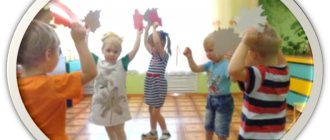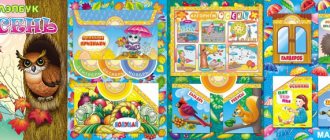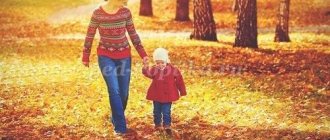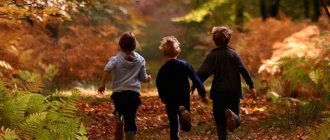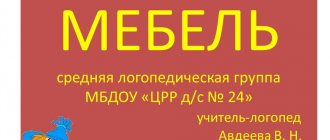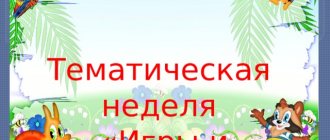Game "Big and small leaves."
Goal: teach the concept of “big - small”.
For the game you will need leaves - large and small.
You can use real autumn leaves or cut out leaves from paper.
The essence of the game: We put large leaves in a large box, and small ones in a small one.
This task will be quite easy to complete for children from 2 to 3 years old.
But children from 1 to 2 years old may have difficulties (“you begin to introduce the baby to a task, and he smiles and runs away from you into another room” - a familiar picture, right?).
In order for the child to cope with the task more successfully, it is important to conduct a “getting to know each other” ritual with the task.
For example:
- Look at the large piece of paper with your child. Say “here’s a big leaf.” Highlight the word “big” in the appropriate voice. “Let’s show how big this leaf is, so big” - we spread our arms wide to the side, showing the “big” sign, we encourage the child to repeat this gesture after you (if he finds it difficult, we spread his arms to the sides ourselves ).
- Take a small leaf. “And this leaf is “small” (we pronounce the word “small” in a “thin” voice.) Let’s show how “small” this leaf is (we bring our hands close to each other, showing the “small size” sign, encouraging the child to repeat this gesture after you , we help him do this if he himself finds it difficult).
This preliminary work - highlighting the words “big” and “small” in a special voice, showing the sizes “big” and “small” with pens - is very important. With its help, the child will better understand the meaning of the task and it will be easier for him to complete it.
3. After you have worked with the concept of “big - small leaf”, you can move on to completing the task. Show your child that large leaves should be put in a large box, and small ones in a small box. Ask him to arrange all the leaves into the boxes correctly.
How you can help your child:
- together determine the size of the leaf (mom says what kind of leaf it is - large or small).
— guide the child’s hand with the piece of paper to the correct size box if the child makes a mistake.
- if the baby finds it difficult to choose the right box, you can simply place the right box under the baby’s hand and ask him to “throw a big piece of paper into the big box.”
It seems that with such “help” the mother does almost everything for the child. But that's not true! In the process of completing a task together, the baby actively learns. His eyes look and remember (he examines large and small leaves), his ears hear and absorb (he constantly hears his mother comparing leaves by size), his hands “do” (kids absorb knowledge very well if it is presented through “movement” ).
After your child completes this task several times with you and with your help, he will feel more confident, better understand all the necessary concepts and begin to cope with similar tasks on his own.
Modeling + color study.
Review with your child two pieces of paper printed on a piece of paper. One of them is red, and the other is yellow (Download a picture with leaves
).
Only the mice ate holes in the leaves! This needs to be corrected urgently.
To play, you will need pre-prepared lumps of soft plasticine - yellow and red.
Show your child that “we will put red lumps on a red leaf and press them down with our fingers, and yellow lumps - on a yellow leaf, so we will close all the holes!”
Most likely, at first the child may get confused and put lumps of plasticine on a leaf of the wrong color. Therefore, actively help your child complete the task - say the name of the color he is currently working with, and tell him which piece of paper to attach the plasticine to.
This game not only develops modeling skills, but also helps to remember colors - during the work, the child will hear the words “red, yellow” from the mother many times, and this will definitely affect how quickly the baby remembers the names of the primary colors.
(When I give similar tasks in the early development group to children from 1 to 2 years old, then first (over several lessons) we always do “preparatory” exercises - we attach yellow plasticine berries to yellow plates drawn on paper, and red “berries” - on red ones, or we attach yellow/red lumps (apples) to yellow and red baskets drawn on paper, etc. - i.e. first we learn to attach yellow plasticine separately from red in a more free form, and only then make it more complicated , asking to attach the plasticine to a certain place).
Lotto "Couples".
Invite your child to play the autumn Lotto. By playing with lotto, kids develop attention and logic, and also expand their vocabulary (if the mother voices the objects drawn in the picture).
(If you are interested in lotto, click on the picture to enlarge the image).
Lacing - mushrooms
Starting from 1.5 years old, your child can learn to string beads on a cord. To teach this skill, it is better to purchase a set of children's beads, which comes with a cord with a wooden needle.
Since our activity is in the autumn, you can string leaves or mushrooms from paper glued onto cardboard onto a string.
You can download the file with mushrooms and leaves by clicking on the image below. Each pair of mushrooms in this picture is “mirror”, so if desired, the mushrooms and leaves can be made double-sided (glued to each other).
A game to develop attention - “find all the leaves in the room.”
Place the leaves throughout the room. Place some of them in visible places, and hide some, but so that the child can still find them.
Ask your child to find all the leaves and put them in a bucket.
Sensory box "Autumn".
Surely your baby will be interested in a sensory box with the theme “Autumn”.
We got something like this, for example:
How to play with the box:
The box can be used to “play” various “autumn” scenes:
“The bunny collects leaves”, “The squirrel is looking for nuts”, “The leaves rustle underfoot.”
It will be interesting for the baby to watch how his mother acts out different scenes (“mini-fairy tales”) using this box, at the same time he will very quickly learn all the “autumn” words.
In addition, many children will enjoy fiddling around in such a box on their own.
Autumn words and pictures.
It would be quite useful to look at pictures with your child on the theme “Autumn” and study “autumn” words: leaves, rain, umbrella, puddles, falling, mushrooms, leaves, yellowed, etc.
Will help:
— Colorful autumn presentations.
— Autumn pictures that you can hang on the walls and periodically discuss them with your child.
— A selection of autumn photographs that can be viewed on a computer screen or printed as cards.
Just look at the illustrations with your child, name the objects that are depicted on them (cloud, leaf, tree, fallen leaf, wet puddle, etc.), ask to find the objects in the picture (show with your finger, where is the tree?), describe what what is drawn in the pictures in simple sentences (it is raining, there are puddles on the ground, the girl is dressed warmly, etc.).
Talking to children about autumn
First, the children need to be told about autumn. There's a lot to talk about! There are a lot of purely autumn themes. Here are just a few of them, offhand.
- Why does autumn come?
- What time of year will replace autumn?
- How is autumn different from other seasons? It is useful to expand on this question. For example, in the fall the leaves turn yellow, apples and other fruits ripen, birds fly south, there are frequent cold rains, the sun shines less and less, and it becomes colder. Each part of this question must be explained to the child at a level he can understand. For example:
- Why does the leaves on the trees turn yellow in autumn?
- Why do birds fly away at this time?
- What are the “warm regions” where the birds are so eager? Will they come back, and when exactly?
- What fruits ripen in the fall and what is made from them? For example, apples are eaten, cabbage is salted, etc.
- It is in the fall that it is best to introduce a child to examples of folk art about this time of year. After all, how many wonderful sayings and proverbs have been invented about autumn! Of course, many of them will be incomprehensible to the child, and therefore mom and dad need to explain their meaning to the baby. It is not difficult to find such proverbs and sayings; they are also on our website here.
- Children's poems, fairy tales and stories on an autumn theme are another wonderful opportunity to tell kids about autumn. There are simply an infinite number of such works written on this topic! At the same time, it would be a good idea to learn a couple of “autumn” poems with your child. They will undoubtedly come in handy - both at matinees and simply for developing children's memory.
- By the way, just like songs about autumn: there are also quite a few of them. Why not learn a few of these songs with your baby? Again - they will come in handy. Well, where there are songs, there is instrumental music. Listening to music about autumn (whether for children or for adults) when it’s autumn outside is great, it perfectly develops creativity!
- But there is also painting! Usually children really like to draw pictures on the theme of autumn. So let them do it.
- Well, how can we do without walks in the autumn park, or even better - in the forest, or along the steppe, or along the river bank (if possible) accompanied by mom and dad! Here the child will have a wonderful opportunity to see autumn “live”, and even with mother’s explanations. However, this is a separate, detailed topic.
Rain - modeling.
It often rains in autumn. Look at the picture with a cloud and droplets with your child, show together “how the rain drips” (“drip-drip-drip”) and tap your fingers on the table.
Then invite your child to make “droplets for a cloud” - let him stick plasticine “droplets” onto a sheet of paper.
This task has three difficulty levels (it is better to choose the one that most suits the child’s level):
1. Simple level (for children who are still not good at sculpting or sculpting for the first time (usually children under 1.5 years old) - the mother puts pre-prepared balls on a sheet of paper and asks the child to press them with his finger.
2. Intermediate level (for children who are already familiar with modeling techniques ) - the child himself takes lumps of plasticine, places them on the paper himself and presses them with his finger.
3. “Advanced” level (for children who are already good at sculpting ) – the baby himself tears off a piece of plasticine from the “sausage” and attaches it to a sheet of paper (specially prepared drops are not required, the baby “makes” them himself).
Learning colors.
This activity will help your child understand the concept of “red and yellow.”
Prepare leaves of two colors - red and yellow.
Examine the leaves, focus the baby’s attention on the fact that some leaves are yellow and others are red.
Then offer to put the yellow leaves in a yellow box, and the red leaves in a red box.
To help complete this task correctly, the same rules as for the previous lesson will help (we actively help the child complete the task, work together with the child, at first it is very useful to literally place the desired “box” under the child’s hand, saying the name of the color out loud (“this is red”) piece of paper, we put it in a red box").
Music of the rain.
Take percussion or noise children's musical instruments that you have at home (or use these “household” instruments that can easily replace musical ones).
Take the child’s hands in yours and try together to “tap” the rhythm to the verses:
Rain, rain, drip and drip!
Don't drip so loudly!
Don't knock on our window!
Better wet the grass!
Drip - drip - drip - drip!
Then turn on the music and invite the child to play a “melody” to the song themselves (play along to Ekaterina Zheleznova’s composition “Rain” ).
The baby will do this with great pleasure if the mother also plays the rhythm on some musical instrument with the child.

